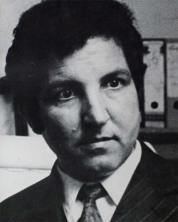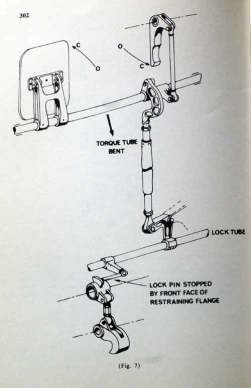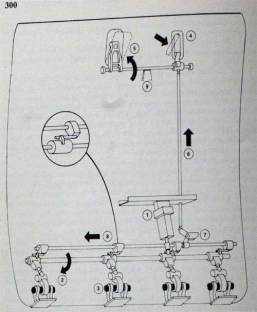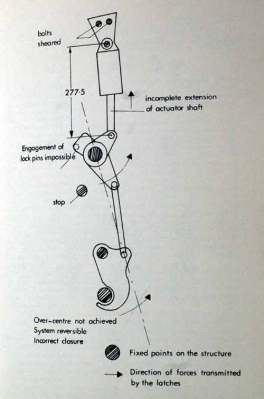La Porte Cargo du DC-10, the internal mechanism the that was guaranteed to close and lock the door securely
The final check was a visual examination through a small peephole to see if the pins were properly over the flange. This was the responsibility of the Turkish ground crew, Also, the micro-switch that engaged when the door is not closed properly did not illuminate in the cockpit to forewarn its doom. To the pilots the cargo door was closed. Unaware to Mohammed Mahmoudi, the pilots and passengers of the Turkish DC-10, the craft had a hidden secret which would reveal itself that day, March 3rd 1974.
Manutentionnaire, Mohammed Mahmoudi est celui qui a fermé la porte cargo du DC-10 n°29 à Orly Sud en activant un interrupteur électrique. Une fois fermé, il a gardé le bouton enfoncé pour conduire les verrous sur les bobines d’ancrage et sur le seuil de la porte. La porte était solidement fermée quand une petite poignée a été repoussé. Cette rotation d’une tringle, un tube enfoncé, a relevé un levier et, hélas, repoussé quatre goupilles de blocage sur la bride de la serrure des crochets.
Le dessin de la porte cargo du DC-10
Although the lock pins jammed against the lugs of the flanges on top of the latches, Mahmoudi was still able to close the vent door without using any force. The top part of the latches had failed to go over center all of the forces created by pressurization after take off were transmitted to the electric actuator. At 11,500 feet the two bolts holding the actuator to the door sheared off and the door blew open and the explosive decompression caused parts of the cabin floor to collapse disrupting cables that controlled the rudder and elevator. It also ejected six passengers into the air.
Bien que les goupilles de verrouillage aient été coincées contre les pattes des brides sur le dessus des loquets, Mahmoudi fût néanmoins capable de fermer la porte, sans la forcer. La partie supérieure des verrous n’a pas réussi à revenir au centre et toutes les forces générées par la pressurisation après le décollage ont été transmises à l’actionneur électrique. À 11.500 pieds (prés de 4.000 mètres) les deux boulons qui retiennent l’actionneur de la porte ont cédés et la porte s’est ouverte. La décompression a causée l’effondrement du plancher de la partie cabine qui est venu perturber les câbles qui contrôlaient le gouvernail de direction et la gouverne de profondeur. Lors de l’incident, six passagers furent éjectés.
A note to readers: Soon after the American incident, modification to the door included a quick fix from the manufacturer. The peep hole, extended rods and a support plate were issued. However, the door of ship # 29 was not completely overhauled. Read the Airworthiness Directive after the Paris crash
Une note aux lecteurs: Peu après l’incident américain, la modification de porte, préconisée par le fabricant du DC-10, proposait une solution rapide et simple. Cependant, la porte de l’appareil DC-10 n ° 29 n’a pas été entièrement refondu. Lire la navigabilité après l’écrasement de Paris.
Mohammed Mahmoudi blamed by.McDonnell Douglas as an “illiterate” baggage handler at Orly for failing to close the door properly. While it was true that Algerian-born Mahmoud Mahamoudi spoke no English, the placard on the door which gave the instruction how to close the door was printed in English.. It should be noted that this was a quick fix to the faulty design of the locking mechanism which should have been fixed soon after the Windsor inciden which involved America Airlines in 1972
Chaque pièce a sa fonction, Bon, Mauvais ou Indifférents
Mohammed Mahmoudi fût accablé par .McDonnell Douglas et présenté comme un bagagiste «analphabète». On lui reprocha de ne pas avoir fermé la porte correctement. Il est exact qu’il ne parlait pas anglais, or la pancarte donnant les instructions de fermeture était rédigée en anglais. Il convient de noter que les accusations portées contre ce bagagiste étaient une explication rapide et simple pour couvrir la mauvaise conception du mécanisme de verrouillage du DC-10. Ce problème aurait dû être fixé peu après l’incident dît de Windsor (American Airlines en 1972) qui avait révélée cette faiblesse.
.................................................................................................................
Richard Bolai / Bruno Druesne © 2008





No comments:
Post a Comment